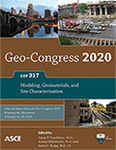Geo-Congress 2020
A New Approach to Simulate Suffusion Processes with MPM
Publication: Geo-Congress 2020: Modeling, Geomaterials, and Site Characterization (GSP 317)
ABSTRACT
Internal erosion is a potential failure mode of earth dams and levees and consists of the mobilization of solid grains as water flows through granular material. This paper focuses on the study of the suffusion mechanism in internally unstable soils. Typically these soils are broadly graded in nature, in which a finer fraction is subjected to erosion and is transported through the voids in the matrix of coarser particles. The material point method (MPM) has shown promise in large deformation modeling of geotechnical problems. Here, an extension of the two-phase double-point MPM formulation is proposed to model the suffusion internal erosion mechanism. MPM is a particle-based method defined in a continuum framework, and the two-phase double-point approach uses two separate sets of material points to represent the liquid and solid phases. Transferring mass between the two layers of material points has applications in fines migration in internal erosion, selective transport in sediment transport, and dissolution of solids. The numerical results demonstrate the capability of the formulation to transfer mass between solid and liquid phases while ensuring that the total mass is automatically conserved.
Get full access to this article
View all available purchase options and get full access to this chapter.
REFERENCES
Abe, K., Soga, K., Bandara, S. (2013). “Material point method for coupled hydromechanical problems.” Journal of Geotechnical and Geoenvironmental Engineering 140 (3): 1–16.
Bandara, S. (2013). “Material point method to simulate large deformation problems in fluid-saturated granular medium.” PhD thesis, University of Cambridge, Cambridge, UK.
Bear, J. (1972). Dynamics of fluids in porous media. Elsevier.
Ceccato, F., Yerro, A., Martinelli, M. (2018). “Modelling soil-water interaction with the material point method. Evaluation of single-point and double-point formulations”, in: Proc. European Conference on Numerical Methods in Geotechnical Engineering, Porto, Portugal, June 2018.
Cividini, A., Gioda, G. (2004). “Finite-element approach to the erosion and transport of fine particles in granular soils.” International Journal of Geomechanics, 4:191–198.
Fern, E.J., Rohe, A., Soga, K., Alonso, E. (2019) “The Material Point Method for Geotechnical Engineering – A Practical Guide.” CRC Press, London.
Jassim, I., Stolle, D., Vermeer, P.A. (2013). “Two-phase dynamic analysis by material point method. International Journal for Numerical and Analytical Methods in Geomechanics.” 37(15): 2502-2522.
Lei, X., Solowski, W. (2019). “MPM simulation of fine particle migration process within unsaturated soils.” in: Proc International Conference on the Material Point Method. Cambridge, UK, January 2019.
Martinelli, M. (2016). “Soil-water interaction with material point method. Double-Point Formulation.” Report on EU-FP7 research project MPM-Dredge PIAP-GA-2012-324522.
Skempton, A.W., Brogan, J.M. (1994). “Experiments on piping in sandy gravels.” Geotechnique, 44(3):449–460.
Sterpi, D. (2003). “Effects of the erosion and transport of fine particles due to seepage flow.” Int. J. Geomech., 3(1/2):111–122.
Sherard, J. L. (1979). “Sinkholes in dams of coarse, broadly graded soils.” 13th Int. In Congress on Large Dams, New Delhi Q(Vol. 49, p. R2).
Sulsky, D., Chen, Z., Schreyer, H.L. (1994). “A particle method for history-dependent materials.” Computer Methods in Applied Mechanics and Engineering 118(1–2): 179–196.
Vardoulakis, I., Stavropoulou, M., Papanastasiou, P. (1996). “Hydro-mechanical aspects of the sand production problem.” Transport in Porous Media, 22:225–244.
Wieckowski, Z. (2013). “Two-phase numerical model for soil-fluid interaction problems.” In Proceedings of ComGeoIII pp.410–41.
Yerro, A., Alonso, E., Pinyol, N. (2015). “The material point method for unsaturated soils.” Géotechnique, 65(3), 201–217.
Yerro, A., Rohe, A., Soga, K. (2017). “Modelling internal erosion with the material point method.” Proc. 1st International Conference on the Material Point Method.” Delft, The Netherlands, January 2017.
Zabala, F., Alonso, E.E. (2011). “Progressive failure of Aznalcóllar dam using the material point method.” Géotechnique, 61(9): 795–808.
Information & Authors
Information
Published In
Geo-Congress 2020: Modeling, Geomaterials, and Site Characterization (GSP 317)
Pages: 482 - 490
Editors: James P. Hambleton, Ph.D., Northwestern University, Roman Makhnenko, Ph.D., University of Illinois at Urbana-Champaign, and Aaron S. Budge, Ph.D., Minnesota State University, Mankato
ISBN (Online): 978-0-7844-8280-3
Copyright
© 2020 American Society of Civil Engineers.
History
Published online: Feb 21, 2020
ASCE Technical Topics:
- Dam failures
- Disaster risk management
- Disasters and hazards
- Engineering fundamentals
- Engineering materials (by type)
- Erosion
- Failures (by type)
- Flow simulation
- Geology
- Geotechnical engineering
- Granular materials
- Man-made disasters
- Material failures
- Materials characterization
- Materials engineering
- Materials processing
- Models (by type)
- Particles
- Piping erosion
- River engineering
- Sediment
- Sediment transport
- Water and water resources
Authors
Metrics & Citations
Metrics
Citations
Download citation
If you have the appropriate software installed, you can download article citation data to the citation manager of your choice. Simply select your manager software from the list below and click Download.
